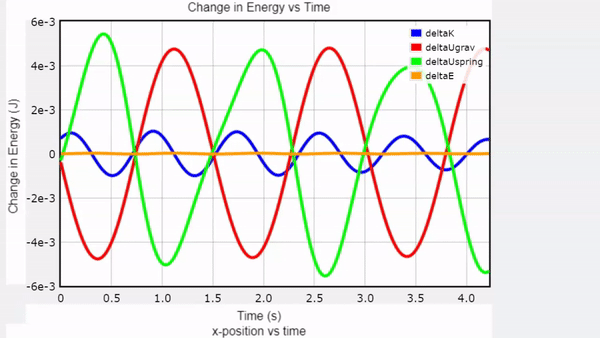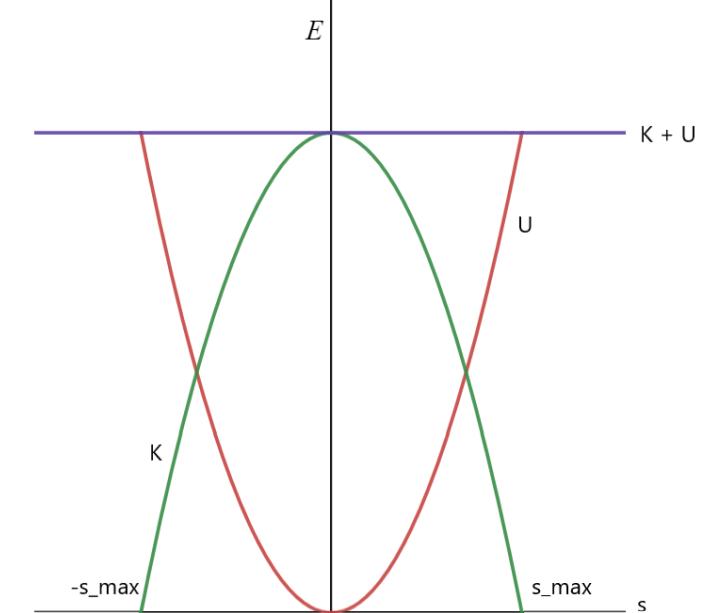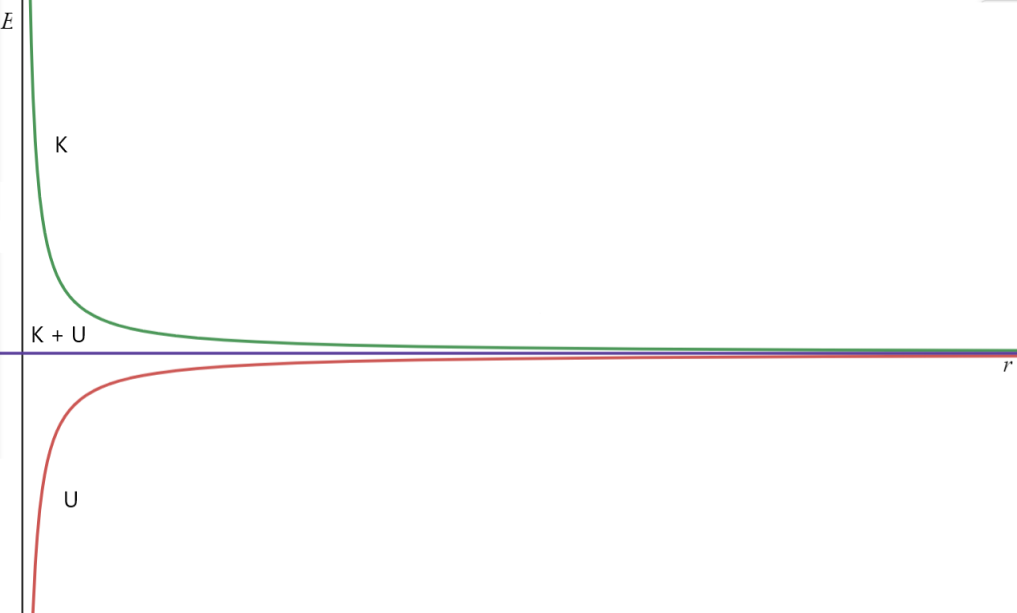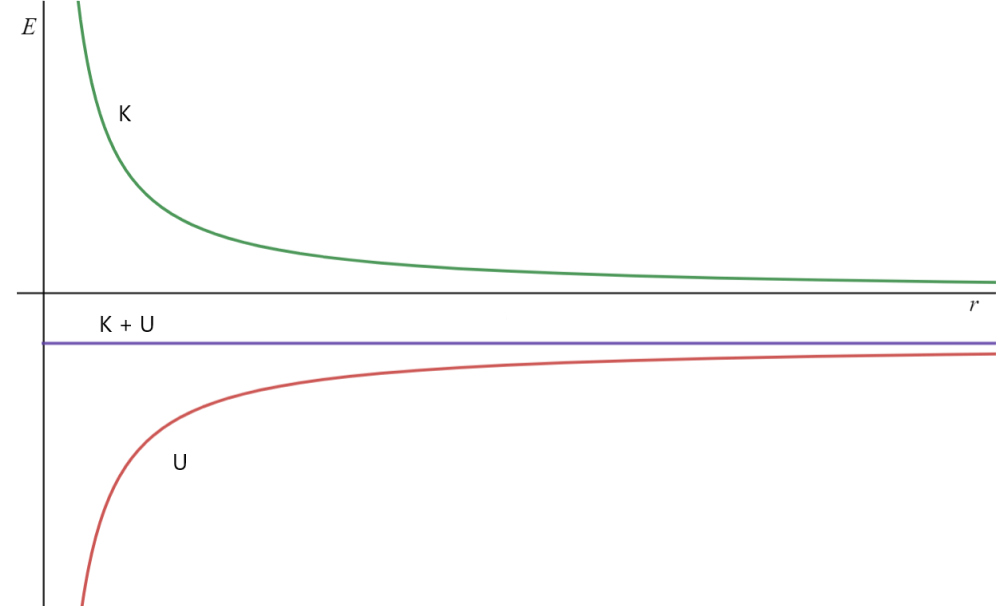How to Create and Interpret Energy Diagrams
The Main Idea
Energy diagrams are tools used to analyze a system's energy and motion with respect to a scalar variable like position or time. They are typically used to represent the kinetic and potential energy within a system, in addition to a horizontal line that depicts the total mechanical energy of the system.
To draw the energy graph of a system, the following method should be used:
- Determine if the potential energy is attractive or repulsive
- For example, gravitational potential energy is attractive since it draws objects to the surface of the Earth [math]\displaystyle{ \left(U_g \lt 0\right) }[/math].
- Electric potential energy for charges with the same sign is repulsive, since like charges repel [math]\displaystyle{ \left(U_e \gt 0\right) }[/math].
- Analyze whether the system is bound, unbound, or at escape speed to determine the location of the total energy line
- Bound System: A system in which the total energy is negative
- [math]\displaystyle{ E = K + U \lt 0 }[/math]; horizontal line is below the x-axis
- The distance between the objects in the system is limited and quantifiable
- Unbound System: A system in which the total energy is positive
- [math]\displaystyle{ E = K + U \gt 0 }[/math]; horizontal line is above the x-axis
- If [math]\displaystyle{ r }[/math] approaches [math]\displaystyle{ \infty }[/math], the distance between the objects in the system is infinite and unquantifiable; the kinetic energy cannot equal 0
- System at Escape Speed: A system in which the total energy is equal to 0
- [math]\displaystyle{ E = K + U = 0 }[/math]; horizontal line is on the x-axis
- Bound System: A system in which the total energy is negative
- Draw the kinetic energy line/curve – this is always positive!
- This is usually the reverse of the potential energy curve because [math]\displaystyle{ K + U = E }[/math]
A Mathematical Model
The mathematical model derived from energy graphs comes down to the fundamental principle: [math]\displaystyle{ E = K + U }[/math], where [math]\displaystyle{ E }[/math] is the total energy, [math]\displaystyle{ K }[/math] is the kinetic energy, and [math]\displaystyle{ U }[/math] is the potential energy (gravitational, electric, spring, etc.) of the system. This model can be modified, however, depending on the type of system:
- Bound System: A system in which the total energy is negative
- [math]\displaystyle{ E = K + U \lt 0 }[/math]; horizontal line is below the x-axis
- The distance between the objects in the system is limited and quantifiable
- Unbound System: A system in which the total energy is positive
- [math]\displaystyle{ E = K + U \gt 0 }[/math]; horizontal line is above the x-axis
- If [math]\displaystyle{ r }[/math] approaches [math]\displaystyle{ \infty }[/math], the distance between the objects in the system is infinite and unquantifiable; the kinetic energy cannot equal 0
- System at Escape Speed: A system in which the total energy is equal to 0
- [math]\displaystyle{ E = K + U = 0 }[/math]; horizontal line is on the x-axis
A Computational Model
Here is a computational representation of the energy diagram for an oscillating spring. View the code segments and the GIF to see how this program is being "run." Follow this link to input your own x and y position data and see the results: https://www.glowscript.org/#/user/roshni22desai/folder/MyPrograms/program/Lab4
The primary snippets of the code are included below.
- Computing the kinetic, gravitational potential, spring potential, and total energies:
K = 0.5 * ball.m * mag(ball.vel)**2 # kinetic energy Ug = ball.m * g * ball.pos.y # gravitational potential energy Us = 0.5 * k_s * s**2 # spring potential energy E = K + Ug + Us # total energy
- Updating the system using Newton's 2nd law and kinematics and computing the resultant changes in each energy:
while t < 7.619:
# Define initial energies
K_i = K
Ug_i = Ug
Us_i = Us
E_i = E
# Calculate gravitational force
Fgrav = vector(0,-ball.m * g,0)
# Calculate spring force on mass by spring
Fspring = -k_s * s * Lhat
# Calculate the net force
Fnet = Fgrav + Fspring
# Apply the Momentum Principle (Newton's 2nd Law)
# Update the object's velocity
ball.vel = ball.vel + (Fnet)/ball.m * deltat
# Update the object's position
ball.pos = ball.pos + ball.vel * deltat
# Update the spring
L = ball.pos - spring.pos
Lhat = L/mag(L)
s = mag(L) - L0
# Calculate energy changes
K = 0.5 * ball.m * mag(ball.vel)**2
deltaK = K - K_i
Ug = ball.m * g * ball.pos.y
deltaUg = Ug - Ug_i
Us = 0.5 * k_s * s**2
deltaUs = Us - Us_i
E = K + Ug + Us
deltaE = E - E_i

Examples
All graphs were created using Desmos.
Simple
The graph below is a representation of the energy of an oscillating spring. The kinetic energy, [math]\displaystyle{ K }[/math], is the least at the maximum points of displacement and greatest at equilibrium, whereas the potential energy, [math]\displaystyle{ P }[/math], is greatest at the maximum points of displacement and lowest at equilibrium. The total energy, [math]\displaystyle{ E }[/math], is at the maximum amplitude of the graph.

Intermediate
This graph corresponds to a system consisting of a proton and electron that begin infinitely far away from each other at rest. This is an example of a system at escape speed; because the electron and proton do not feel forces from each other, as shown by the fact that they are both at rest, they have effectively "escaped" the influence of the other, so the total energy must be equal to 0 by the above principles. Alternatively, since both particles are at rest, their kinetic energies approach 0 at infinity, as does their potential energies.

Difficult
This graph corresponds to a system a comet orbiting the Sun and passes it every 75 years. Although the orbit is very large, it is still bound to the Sun, making it a bound system with the total energy less than 0. In this case, the magnitude of the potential energy is larger than the magnitude of the kinetic energy, which causes the total energy to be less than 0, unlike the previous example.

Connectedness
One of my strongest passions is sustainability and conservation, particularly renewable energy systems. Energy diagrams, as we have learned, provide information about the kinetic and potential energies of a system. For example, the potential energy within a dam could be determined from the elevation of water, while the kinetic energy of the water could be found by analyzing its speed due to currents and turbines. This also ties into how energy graphs connect with my major, Materials Science and Engineering. Although this field has several paths, one route that I am interested in is how materials can be engineered to prevent or solve environmental problems. As a result, energy diagrams are beneficial in many industrial applications, including optimizing processes to control pollution and developing methods to minimize both household and industrial waste. Apart from environmental engineering, though, energy diagrams can be used to in electronics and semiconductors as well and are important for understanding how to design electronical equipment and enhancing performance of batteries, which contain electric potential energy that allows for the kinetic flow of electrons. Furthermore, energy diagrams are used to analyze on a smaller molecular scale as well, by representing changes in chemical reactions and catalytic processes.
History
The concept of mechanical energy was discovered by James Prescott Joule, who analyzed that different kinds of energy (kinetic, thermal, chemical, etc) could be converted between one another. From this he developed the law of conservation of energy, the idea that energy can neither be created nor destroyed. The representation of this energy, through mechanical energy diagrams, however, was first brought about by scientist Alfred Clebsch. He used these diagrams to visualize how a system contains several different kinds of energy, but this energy is transferred through time, making the total energy absolute. Although Clebsch's diagrams were initially looked upon by doubt, they were ultimately used by several scientists to analyze the motion of objects both on Earth and in space.
See also
Here are some interactive simulations to that may help with understanding representation of energy conservation!
- PhET simulation to understand the conservation of energy within a system
- PhET simulation to obtain a better understand of energy conservation in springs
Further reading
- Article to learn more about the Law of Conservation of Energy
- Article to highlight important observations about energy diagrams and how to interpret them
External links
Video explaining how to read spring energy graphs: https://www.youtube.com/watch?v=HuV8itFrht4 Video discussing the concept of mechanical energy: https://www.youtube.com/watch?v=VrLVUfB_t_U
References
Notes used as reference from Padukka lecture notes, Fall 2023 https://phys.libretexts.org/Courses/University_of_California_Davis/UCD:_Physics_9HA__Classical_Mechanics/3:_Work_and_Energy/3.7:_Energy_Diagrams https://www.dummies.com/article/academics-the-arts/science/quantum-physics/measuring-the-energy-of-bound-and-unbound-particles-161223/